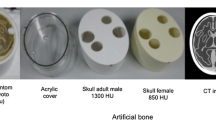Summary
We present a method for brain single photon emission computed tomography (SPECT) analysis based on individual registration of anatomical (CT) and functional (133Xe regional cerebral blood flow) images and on the definition of three-dimensional functional regions of interest. Registration of CT and SPECT is performed through adjustment of CT-defined cortex limits to the SPECT image. Regions are defined by sectioning a cortical ribbon on the CT images, copied over the SPECT images and pooled through slices to give 3D cortical regions of interest. The proposed method shows good intra- and interobserver reproducibility (regional intraclass correlation coefficient ≈0.98), and good accuracy in terms of repositioning (≈3.5 mm) as compared to the SPECT image resolution (14 mm). The method should be particularly useful for analysing SPECT studies when variations in brain anatomy (normal or abnormal) must be accounted for.
Similar content being viewed by others
References
Ingvar DH, Risberg J (1967) Increase of regional cerebral blood flow during mental effort in normals and in patients with focal brain disorders. Exp Brain Res 3:195–211
Roland PE, Larsen B (1976) Focal increase of cerebral blood flow during stereognostic testing in man. Arch Neurol 33:551–558
Heller SL, Goodwin PN (1987) SPECT instrumentation: performance, lesion detection, and recent innovations. Semin Nucl Med 17:184–199
Cordes M, Christe W, Henkes H, et al (1990) Focal epilepsies: HM-PAO SPECT compared with CT, MR, and EEG. J Comput Assist Tomogr 14:10–19
Gemmel HG, Sharp PF, Besson JAO, et al (1987) Differential diagnosis in dementia using the cerebral blood flow 99mTc HM-PAO: a SPECT study. J Comput Assist Tomogr 11:398–402
Goldenberg G, Podreka I, Hoell K, Steinert M (1987) Patterns of regional cerebral blood flow related to memorizing of high and low imagery words: an emission computer tomography study. Neuropsychologia 25:473–485
Stephan H, Bauer J, Feistel H, et al (1990) Regional cerebral blood flow during focal seizures of temporal and frontocentral onset. Ann Neurol 27:163–166
Montaldi D, Brooks DN, McColl JH, et al (1990) Measurements of regional cerebral blood flow and cognitive performance in Alzheimer's disease. J Neurol Neurosurg Psychiatry 53:33–38
Lou HC, Henriksen L, Bruhn P (1990) Focal cerebral dysfunction in developmental learning disabilities. Lancet 335:8–11
Seitz RJ, Greitz T, Roland PE, et al (1990) Accuracy and precision of the computerized brain atlas programme for localization and quantification in positron emission tomography. J Cereb Blood Flow Metab 10:443–457
Friston KJ, Passingham RE, Nutt JG, Heather JD, Sawle GV, Frackowiak RS (1989) Localization in PET images: direct fitting of the intercommissural (AC-PC) line. J Cereb Blood Flow Metab 5:690–695
Fox PT, Perlmutter JS, Raichle ME (1985) A stereotactic method of anatomical localisation for positron emission tomography. J Comput Assist Tomogr 9:141–153
Junk I, Moen JG, Hutchins GD, Brown MB, Kuhl D (1990) Correlation methods for the centering, rotation, and alignment of functional brain images. J Nucl Med 31:1220–1226
Talairach J, Szikla G, Tournoux P et al (1967) Atlas d'anatomie stéréotaxique du télencéphale. Masson, Paris
Steinmetz H, Fürst G, Freund H. J. (1989) Cerebral cortical localization: application and validation of the proportional grid System in MR imaging. J Comput Assist Tomogr 13:10–19
Matsui T, Hirano A (1978) An atlas of the human brain for computerized tomography. Igaku-Shoin, New York
Gelbert F, Bergvall U, Salamon G, et al (1985) CT identification of cortical speech areas in the human brain. J Comput Assist Tomogr 10:39–45
Celsis P, Goldman T, Henriksen L, Lassen NA (1981) A method for calculating regional cerebral blood flow from emission computed tomography of inert gas concentrations. J Comput Assist Tomogr 5:641–645
Rezai YK, Kirchner PT, Armstrong C, Ehrhardt JC, Heista D (1988) Validation studies for brain blood flow assessment by radioxenon tomography. J Nucl Med 29:348–355
Stokely EM, Bonte FJ, Devous MD, Arora G (1988) Brain blood flow by radioxenon tomography. J Nucl Med 29:1875–1976
Serra J (1982) Image analysis and mathematical morphology. Academic Press, London
Martinot JL, Allilaire JF, Mazoyer BM, et al (1990) Obsessivecompulsive disorder: a clinical neuropsychological and positron emission tomography study. Acta Psychiatr Scand 82:233–242
Mazziotta JC, Koslow SH (1987) Assessment of goals and obstacles in data acquisition and analysis from emission tomography: report of a series of international workshops. J Cereb Blood Flow Metab 7:S1-S31
Tzourio N, Mazoyer BM, Raynaud C, Lorre JP, Syrota A (1989) Positioning of cortical regions of interest on SPECT images: a critical study of the isocontour method. J Nucl Med 30:877
Geschwind N, Levitsky W (1968) Human brain left-right asymmetries in temporal speech region. Science 161:186–187
Mintum MA, Fox PT, Raichle ME (1989) A highly accurate method of localising regions of neuronal activation in the human brain with positron emission tomography. J Cereb Blood Flow metab 9:96–103
Correira A (1990) A Registration of Nuclear medicine images. J Nucl Med 31:1227–1229
Pelizzari CA, Chen GTY, Spelbring DR, Weichselbaum RR, Chen C. T (1989) Accurate three-dimensional registration of CT, PET, and/or MR Images of the brain. J Comput Assist Tomogr 13:20–26
Author information
Authors and Affiliations
Rights and permissions
About this article
Cite this article
Tzourio, N., Joliot, M., Mazoyer, B.M. et al. Cortical region of interest definition on SPECT brain images using X-ray CT registration. Neuroradiology 34, 510–516 (1992). https://doi.org/10.1007/BF00598963
Received:
Issue Date:
DOI: https://doi.org/10.1007/BF00598963




